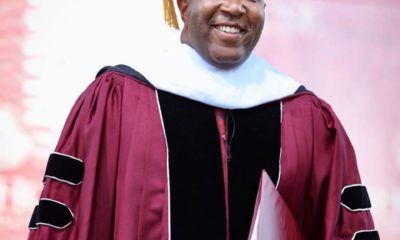Business
Italy’s Uffizi Gallery wants WWII-stolen painting back from Germany
Italy’s Uffizi Gallery opened 2019 by an appeal to the German government to finally return “Vase of Flowers” artwork by 18th-century Dutch artist Jan van Huysum. The painting was stolen during World War II and had been subjected to negotiation since 1991.

World War II, which lasted from 1939 to 1945, saw the rise of Nazi Germany, a common name for the country when it was ruled by the infamous Adolf Hitler. While people would always associate this era with the Holocaust, high-ranking Nazi soldiers had also engaged in widespread cultural looting.
The recovery of their plunder continues up until the present. But, while Germany has committed to help with the recovery, the country has been facing criticisms with its seemingly slow action regarding the matter. Such is the case with the 18th-century Dutch artist Jan van Huysum’s “Vase of Flowers” of which legal ownership belongs to Italy.
On Jan. 1, Uffizi Gallery, one of Italy’s biggest art galleries, made an appeal to the German government to return the artwork to the country.
Eike Schmidt, who is heading the Uffizi Gallery, has taken to Twitter to make Italy’s appeal known to Germany. He has also posted a video on YouTube to send his message across.
“An appeal to Germany for 2019: We hope that this year may finally see the return to the Uffizi Gallery in Florence of the celebrated work of art entitled Vase of Flowers,” Schmidt wrote in a statement that comes with the YouTube video.
Schmidt said the missing “Vase of Flowers” has created a gap in the gallery’s still-life paintings archive and the void merits to be filled.
“This story is preventing the wounds inflicted by World War II and the horrors of Nazism from healing. Germany has a moral duty to return this painting to our museum and I trust that the German Government will do so at the earliest opportunity,” Schmidt’s appeal reads.
Until then, he is hanging a black-and-white replica of the painting with the word “stolen” written in Italian, in English, and in German.
The gallery has yet to reveal the painting’s worth, but a similar painting by the same artist was sold for $218,500 during an auction in New York.
How Jan van Huysum’s ‘Vase of Flowers’ disappeared
The “Vase of Flowers” was originally in the possession of Grand Duke Leopoldo II of Tuscany. In 1824, he had it on display at the Palatine Gallery in the Pitti Palace along with other important artwork during the era.
When the Pitti Palace was evacuated during World War II, the paintings were transferred to the Medici Villa at Poggio a Caiano in Florence. The paintings were then moved to Villa Bossi Pucci, which is outside of Florence. From there, Nazi soldiers brought the paintings to unknown locations northward and the “Vase of Flowers” has disappeared from the public record from that point on.

Jan van Huysum’s “Vase of Flowers”. (Source)
Debate over the return of the ‘Vase of Flowers’
The first verifiable information about the piece emerged in 1991. It was found that the “Vase of Flowers” has been in the possession of a family who refused to be identified. Italy has since been negotiating with organizations acting on behalf of the family. Schmidt said there is a possibility that the family was related to the soldier who stole the painting.
Most recently, the family asked $567,000 in exchange for the artwork. Italy, however, did not give in. Schmidt explained Italian laws forbid the gallery from buying something that the country legally owned. The family’s action may, in fact, constitute extortion under Italian laws, he said.
On the other hand, German authorities said they no longer have a say on the matter as Germany’s local laws stated that crimes committed more than 30 years could no longer be prosecuted.
Italy has its own collection of stolen art
While Italy is aggressively finding all legal means to recover the “Vase of Flowers,” art experts are also quick to point out that the country is keeping its own loot of art collection stolen during World War II, the New York Times reported.
In fact, Italy was among the five countries called out during a stolen art summit held in November 2018 in Berlin.
Stuart Eizenstat, an adviser for the U.S. State Department, had called out Italy, Poland, Spain, Russia and Hungary for their seeming reluctance to return stolen art which remains in their keeping since World War II.
The five countries were called out in line with the Washington Principles treaty which 44 nations agreed to sign in 1998. The treaty stated that all signatories would do their best to return stolen artwork. Eizenstat said there were approximately 600,000 paintings stolen during World War II and 100,000 are still missing.
As for Italy, Eizenstat said the country appeared to be more interested in recovering paintings that were taken away from them instead of returning looted art it keeps in its galleries at present.
“Italian government had not carried out ‘provenance research or listing of possible Nazi-looted art in their public museums,’ and that Italy appeared to be more interested in ‘what the Italian government lost,’” the New York Times quoted Eizenstat as saying.
(Featured image by Chris Wee via Wikimedia Commons. CC BY 2.0.)

-

 Markets1 week ago
Markets1 week agoSugar Markets Cautious Amid Surplus Outlook and Steady Demand
-

 Crypto2 days ago
Crypto2 days agoEthereum Momentum Builds as Bitcoin Rallies and Trilemma Claims Emerge
-

 Crowdfunding1 week ago
Crowdfunding1 week agoCrowdfunding Grants Open for Business Projects Until January 2026
-

 Biotech1 day ago
Biotech1 day agoHaptena Therapeutics Launches with €3 Million Funding to Target KRAS-Mutated Tumors


























You must be logged in to post a comment Login